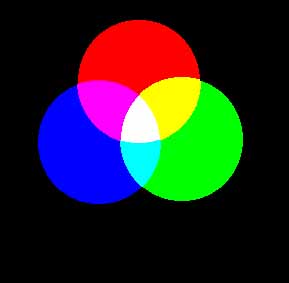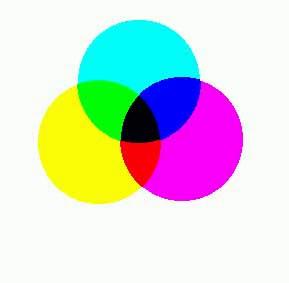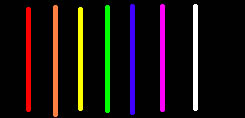-- pretend these are colored spotlights
and a magenta filter
--pretend we are viewing white light
through overlapped filters.



| Color Addition | Color Subtraction |
| Mixing red light, blue light, and green light
-- pretend these are colored spotlights |
Combining an aqua filter, a yellow filter,
and a magenta filter --pretend we are viewing white light through overlapped filters. |
 |

|
| Red light + Blue light=Magenta | Magenta filter + Yellow filter=Red |
| Red light + Green light=Yellow | Yellow filter +Aqua filter=Green |
| Blue light + Green light = Aqua (also called Cyan) | Aqua filter+Magenta filter=Blue |
These pictures are not actual photographs of real filters, of course; they are made by turning on and off the red, blue, and green dots on the computer screen. You can try to reproduce them with the filters in the kit. To do color addition, you have to shine white light through the filters (to make colored light) and then overlap the colored light beams on a screen. You would need three light stations (or three overhead projectors); it works pretty well and is actually fun to do (it is one of the things proposed in the discussion section).
Overlapping the filters is much easier, but what you will get does not look quite like what the theory predicts. The problem is that the real filters are not perfect -- the blue filter lets some red and green light leak through, and the green filter lets a lot of blue and some red leak through. So a yellow object, seen through the real blue filter, does not look black -- it looks dull yellow.
So our eyes are not telling us the truth, our brain is covering up for our eyes, and the color filters are not quite what they claim to be. It must have been really difficult to unravel this subject!